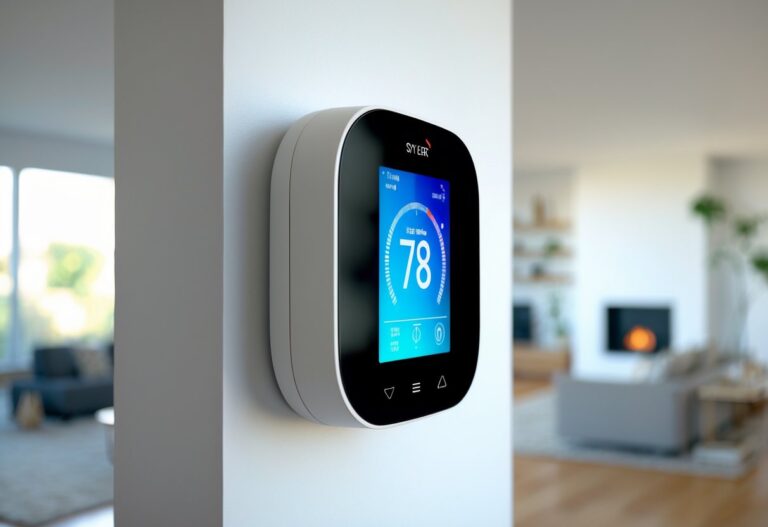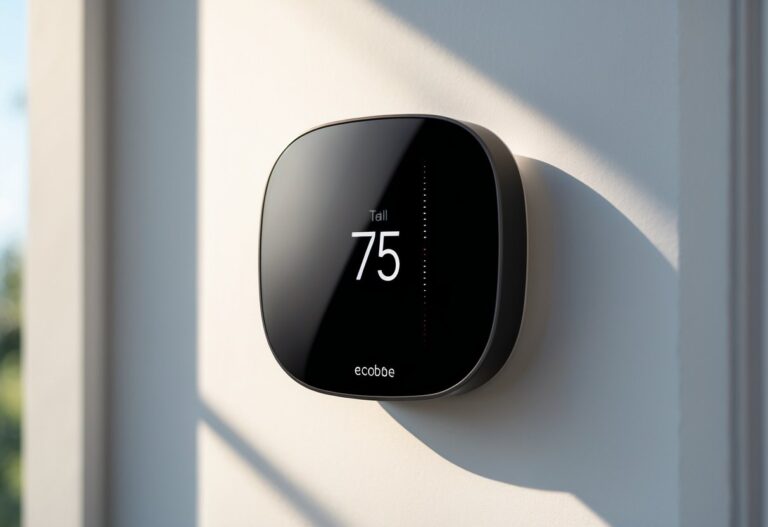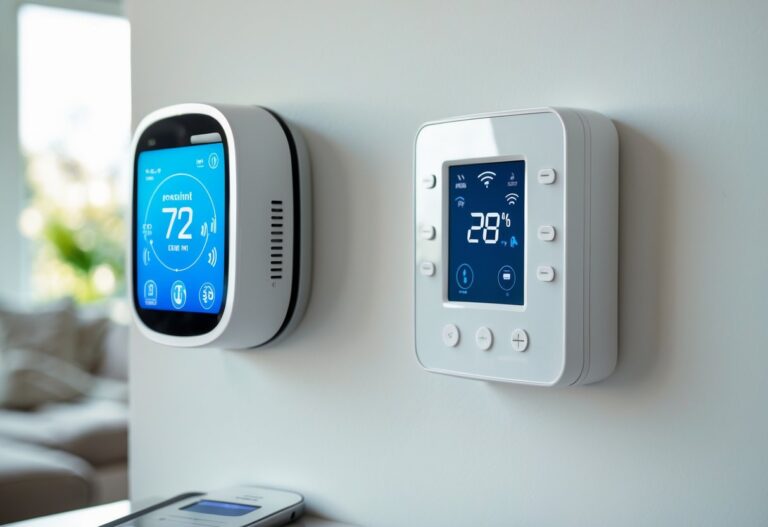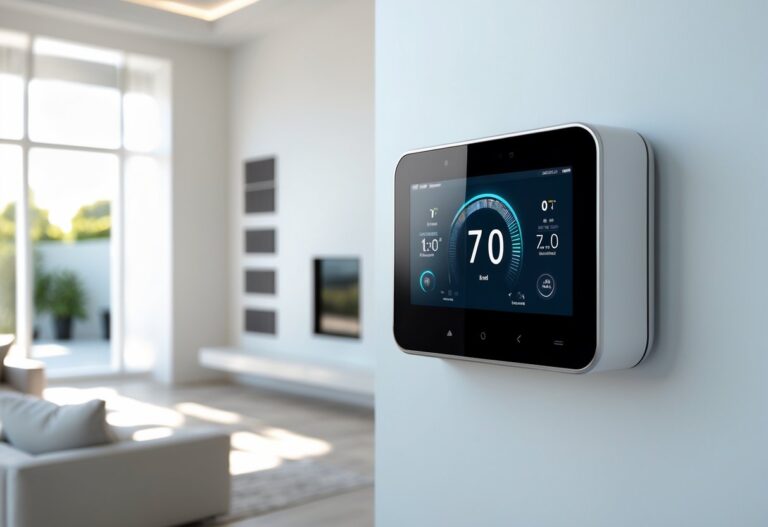Smart thermostats can help you save money, keep your home comfortable, and make life easier. Many popular smart thermostats work with Google Home, so you can control your heating and cooling using voice commands or your phone. Nest, Ecobee, and Honeywell models are all compatible with Google Home, giving you several good options to choose from.

You might want features like easy installation, smart schedules, or energy reports. Each compatible thermostat offers something different, so picking the right one for your home is important. With the right smart thermostat, you can enjoy hands-free control and a smarter, more efficient house.
Key Takeaways
- There are several top smart thermostats that work well with Google Home.
- Features, setup, and smart technology may differ between brands.
- Pairing the right thermostat can boost comfort and energy savings.
Top Smart Thermostats Compatible With Google Home
Many smart thermostats work with Google Home, letting you adjust the temperature using voice commands or the Google Home app. Popular options include models from Nest, ecobee, Honeywell, and Emerson Sensi, each offering different features and compatibility.
Google Nest Thermostats
Google Nest thermostats are designed to work smoothly with Google Home. Models like the Nest Learning Thermostat and the entry-level Google Nest Thermostat allow you to control your home’s temperature through the Google Home app and by using your voice with Google Assistant.
The Nest Learning Thermostat offers features such as learning your schedule, automatic adjustments, and energy reports. The device can help save energy by turning itself down when you are away and can be managed remotely. The lower-priced Google Nest Thermostat still offers voice control and remote access, but without the advanced learning features.
Setting up a Nest thermostat with Google Home is simple. After connecting to Wi-Fi, you can add the device in the Google Home app and start using voice commands like “Hey Google, set the temperature to 72 degrees.” Compatibility is strong as both products are made by Google, so integration is reliable.
ecobee SmartThermostat Series
The ecobee SmartThermostat series, including the ecobee SmartThermostat with voice control and older models like the ecobee4, also work with Google Home. These thermostats connect over Wi-Fi and can easily sync to your Google account.
With ecobee, you can control your thermostat using the Google Home speakers or your phone. The ecobee4 thermostat and newer models support features like room sensors, remote temperature management, and energy tracking. You can adjust the temperature, set schedules, and ask Google to check your home’s climate.
ecobee thermostats are known for accuracy and can improve comfort by using multiple sensors in different rooms. Voice commands like “Hey Google, turn up the heat” work once the device is linked in the Google Home app. They also work with other platforms, giving you flexibility.
Honeywell Thermostats
Honeywell offers several smart thermostats compatible with Google Home, such as the Honeywell Lyric T5 and some T9 and T10 models. These thermostats can be linked to your Google account to support voice commands through Google Assistant.
The Lyric T5 lets you set schedules, adjust temperatures remotely, and receive alerts for maintenance or extreme conditions. It uses Wi-Fi and can be controlled in the Google Home app or by saying, “Hey Google, set the thermostat to cool.” Features like geofencing let your thermostat react when you leave or return.
Honeywell thermostats support both traditional and smart home heating and cooling systems. Their straightforward interface makes them a good choice if you want an easy experience with Google Home compatibility.
Emerson Sensi Lineup
The Emerson Sensi Wi-Fi Thermostat and the Sensi Touch are popular for Google Home users. Both models connect to your Wi-Fi and allow for voice commands and remote control through the Google Home app.
Sensi thermostats are valued for their simple setup and reliable performance. Core features include flexible scheduling, alerts, and compatibility with many home HVAC systems. The Sensi Touch has a touchscreen display, while the standard Sensi Wi-Fi Thermostat offers basic controls.
These Emerson thermostats make it easy to manage your home’s climate with your voice or from anywhere using Google Home. Installation instructions are clear, and you can start using Google Assistant after linking your Sensi account in the app.
Key Features And Advanced Technology
Smart thermostats that work with Google Home use a mix of advanced features and smart technology. They help you control your home’s climate easily, save energy, and connect with other smart home devices for added convenience.
Voice Control And Google Assistant Integration
With voice control, you can change the temperature, set schedules, or turn your system on and off using simple commands. Just say, “Hey Google, turn up the heat,” and your thermostat will respond. This hands-free control is helpful if you’re busy or have your hands full.
Smart thermostats like Nest, Ecobee4, and Honeywell Lyric T5 can connect with Google Assistant. Once linked, you get easy access to settings on your phone or smart speaker. Voice command support also means you can check your thermostat’s status without touching a button.
Integration with Google Assistant ties your thermostat to other smart home systems. For example, your thermostat can work in routines with other smart devices, so saying one command can adjust lighting, locks, and temperature all at once. This makes managing your home more simple and efficient.
Geofencing And Smart Automation
Geofencing technology uses your phone’s location to tell if you’re home or away. Your thermostat will automatically adjust the temperature when you leave, then restore it before you return, which saves energy and keeps your home comfortable.
Most advanced smart thermostats support this feature. It helps you avoid heating or cooling an empty house. You can also create smart home automation routines using services like IFTTT to trigger changes in temperature when you cross certain locations or at specific times.
This type of automation means you don’t have to think about adjusting the thermostat each day. It works in the background, offering both convenience and energy savings. Many smart home devices now use geofencing to help automate your routine.
Scheduling And Temperature Control
Scheduling options let you program your thermostat to follow a daily or weekly plan. You can set different temperatures for when you wake up, leave for work, come home, or sleep. Some thermostats offer simple calendar-style planners, while others use easy drag-and-drop interfaces.
Temperature control is precise and consistent. You can change the temperature from your phone, a tablet, or with voice commands through Google Home. Many models even let you set different schedules for weekends or special days.
With remote access, you can adjust your home’s temperature from anywhere. If your plans change, just use the app or Google Assistant to update your schedule. This flexibility makes it easy to keep your home comfortable and energy efficient.
Learning Capabilities And Self-Learning
Some smart thermostats have learning capabilities, which means they can track your habits and automatically make changes. For example, the Nest Learning Thermostat observes your adjustments and starts creating a custom schedule after about a week.
Self-learning thermostats can also react to changes in your routine. If you start coming home earlier or leaving later, the thermostat may adjust to keep your home the right temperature when you need it.
This technology helps save energy without much effort from you. These advanced features reduce the need for manual scheduling. Over time, your thermostat fine-tunes its actions, making your home more comfortable and efficient with less work from you.
Compatibility And Installation Requirements
When choosing a smart thermostat for Google Home, you need to pay attention to your current HVAC system, wiring, and the way the device connects with your smart home platforms. These factors help you avoid extra costs and setup problems.
HVAC System Compatibility
Many smart thermostats, such as Nest and Ecobee, work with most 24 V heating and cooling systems. This includes common types like natural gas, electric, and oil systems. Most homes with standard HVAC setups can use these thermostats without major problems.
If you have an older or unusual HVAC system, such as high-voltage (line voltage) heaters or millivolt systems, some smart thermostats may not be compatible. It’s important to check the thermostat’s website or manual for a compatibility chart before you buy.
Common compatible systems include:
| System Type | Usually Compatible? |
|---|---|
| Central Heating/Cooling (24V) | Yes |
| Heat Pumps | Yes* |
| Line Voltage (120/240V) | No |
| Millivolt | No |
*Some heat pumps may need extra wiring.
C-Wire And Power Requirements
Most smart thermostats, like Honeywell Lyric T5 or Nest, need a continuous power source called a C-wire (common wire). The C-wire ensures stable power for Wi-Fi and smart features. Without it, your thermostat may not work right or could drain batteries quickly.
If your current wiring does not have a C-wire, some smart thermostats come with a power extender kit or other adapters. Others, like some Nest models, can run without a C-wire in some cases, but performance may vary. Always check your wiring before installing.
Here’s a quick checklist for wiring needs:
- Check if you have a C-wire (typically blue or black).
- If not, see if a power adapter is included or needed.
- Confirm the model’s power needs in its specs.
Integration With Smart Home Platforms
Smart thermostats need Wi-Fi to connect with your Google Home Mini, Google Home Hub, or other smart devices. Not all smart thermostats work with every platform.
Common models like Nest Learning Thermostat, Ecobee4, and Honeywell Lyric T5 work smoothly with Google Home for voice control and automation. Some models also support Apple HomeKit and Amazon Alexa, so you can use several assistants if you prefer.
Use the device’s app or the Google Home app to add and manage your thermostat. Always make sure your Wi-Fi is stable for the best experience. If you switch between smart platforms, check that your thermostat supports each one you plan to use.
Performance, Energy Efficiency, And User Experience
Smart thermostats that work with Google Home offer features that help you control your home’s climate, save on energy costs, and easily manage settings from anywhere. The combination of performance, energy-saving technology, and user-friendly design makes these devices a strong choice for your home.
Energy Consumption And Savings
Smart thermostats like the Google Nest Learning Thermostat or the Honeywell Home T5 focus on reducing your energy use. They use features such as Auto-Schedule and adaptive eco modes to learn your daily routines and adjust heating or cooling accordingly. This means the system runs less when you’re not home, helping to lower your energy bills.
Most models compatible with Google Home also give you access to detailed energy reports. These reports show how much energy you use and suggest ways to save even more. Some thermostats can save between 8% and 16% on your heating and cooling bills with regular use.
You can review your energy consumption right from your phone. This helps you notice patterns and make changes quickly. Smart thermostats track and show your savings, making it clear what changes have the biggest impact on your energy bills.
Remote Access And Control
With Google Home integration, smart thermostats allow you to control your home’s temperature from anywhere. You can use the Google Home app, the thermostat’s own smartphone app, or your voice with a compatible speaker. This makes it easy to make changes, even when you’re away.
Many devices offer geofencing, which automatically adjusts the temperature when you leave or return home. For example, Honeywell’s T5 uses location data to decide when to turn the system on or off. This prevents wasted energy without you needing to remember a schedule.
You can quickly adjust temperatures, set up schedules, or turn systems off right from your phone. The ability to manage your settings remotely means you never have to come home to an uncomfortable house or worry about energy being wasted.
Design And Interface
Smart thermostats designed for Google Home usually feature sleek looks and simple controls. Many have touchscreens or bright displays, making them easy to read and use. Models like the Nest Learning Thermostat use an elegant round design with a clear glass front, fitting in well with modern home styles.
Interfaces are straightforward, with large numbers and clear menus. You don’t have to dig through complex settings to change the temperature or view energy reports. Most thermostats also have simple installation guides, so you can set them up quickly.
Some thermostats allow you to adjust brightness, change themes, or show useful data like weather. Controls on both the device and the app are usually intuitive, ensuring you can operate the thermostat even if you’re not tech-savvy.
Customer Support And App Features
Brands that make Google Home-compatible thermostats tend to offer helpful customer service. If you have questions during installation or problems with the device, you can usually get answers quickly from online chat, detailed help guides, or customer support phone lines.
The smartphone apps that come with these thermostats offer a range of helpful features. You can get push notifications about maintenance reminders, low battery, or system issues. The Nest app and others allow you to view your energy usage, change settings, or set up schedules with just a few taps.
Most brands keep their apps up to date and provide regular firmware updates to fix bugs or add new features. This helps make sure your thermostat stays reliable and secure. With these supports in place, you can solve most problems without a lot of stress or extra cost.





